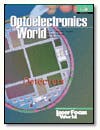From practical applications to basic science
The articles in this Optoelectronics World supplement start out in the realm of practical applications and then work progressively into fundamental science. The first article, written by Lester Kozlowski of the Rockwell Science Center in Thousand Oaks, CA, compares the capabilities of charge-coupled device (CCD) and complementary metal oxide semiconductor (CMOS) technology for low-light-level imaging. For a couple of decades, CCDs have been the preferred solid-state imaging sensor in the visual range. The technology is mature and proven, and engineering solutions have successfully extended its utility into the low-light regime for numerous applications. A migration to CMOS technology for low-light-level applications has begun, however, because of CMOS advantages such as pixel-based amplification, low temporal noise at video rates, and on-chip integration of camera-related functions. Kozlowski's excellent article explains these and other comparative factors in detail, all within the practical application context of low-light-level imaging.
The second article, written by Michael Lange, Peter Dixon and Marshall Cohen at Sensors Unlimited (Princeton, NJ), along with Jian Zhao at Rutgers University (Newark, NJ), delves into the fundamentals of p-n junction formation in the fabrication of indium phosphide (InP)-based devices, such as photodiodes and diode lasers. Currently, 50-mm-diameter InP wafers are satisfying the demand for components based on this technology, according to the authors. But the recent influx of devices such as near-infrared cameras, dense-wavelength-division-multiplexing monitors, large-area power meters and VCSEL arrays that integrate large numbers of components into comparatively large footprints may soon exert pressure on the industry to increase the size of the wafers to 100-mm diameters. To meet this projected demand, the authors describe the use of a spin-on-glass technique for p-n junction formation that is low-cost, scalable to large wafers, and compatible with automated wafer-handling and process control.
In the final article, I explore the work of researchers at the Lawrence Berkeley National Laboratory who have used photodiode design principles from particle physics to develop a detector for exploring fundamental scientific questions about the nature of the universe. To detect far red-shifted light from 10 billion-year-old supernovae, the LBNL research team has fabricated a CCD with a 300-µm-thick depletion region, more than an order of magnitude thicker than conventional astronomical CCDs. The design is likely to find numerous applications beyond supernova astronomy, including practical ones such as process control in semiconductor manufacturing. The initial impetus for developing the device, however, came out of a drive to answer some of the most fundamental and blue-sky questions of basic science.
Hassaun Jones-Bey
Senior Editor
[email protected]


